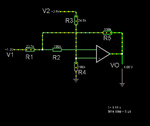AssemblyLine
Member level 1
I need some help in deriving the output voltage of the following circuit
My calculations does not seem to match the simulations

I have computed the output voltage as
(K1/K3)*V2 - (K2/K3)*V1
K1=R4/(R3+R4)
K2=( R2//R5 ) / ( R1 + R2//R5 )
K3=( R1//R2 ) / ( R5 + R1//R2 )
Numerically it leads me to Vo=4.58*V2-4.21*V1 ...But it does not match the simulation
My calculations does not seem to match the simulations

I have computed the output voltage as
(K1/K3)*V2 - (K2/K3)*V1
K1=R4/(R3+R4)
K2=( R2//R5 ) / ( R1 + R2//R5 )
K3=( R1//R2 ) / ( R5 + R1//R2 )
Numerically it leads me to Vo=4.58*V2-4.21*V1 ...But it does not match the simulation

